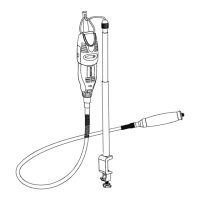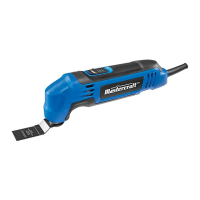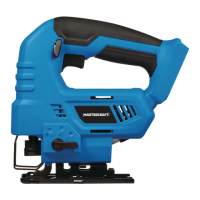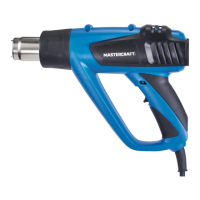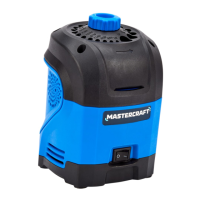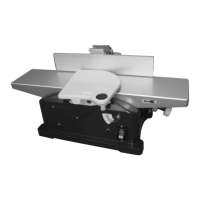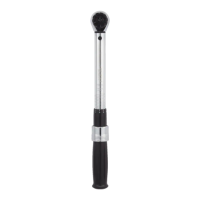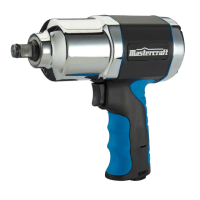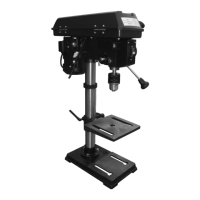Disconnect the plug from the power source before making any adjustments, changing
accessories or storing the tool. Such preventive safety measures reduce the risk of starting the tool
accidentally.
Store idle tools out of reach of children and other untrained persons. Tools are dangerous in the hands
of untrained users.
Maintain tools with care. Keep cutting tools sharp and clean. Properly maintained cutting tools with
sharp cutting edges are less likely to bind and are easier to control.
Check for misalignment or binding of moving parts, breakage of parts and any other condition that
may affect the tool’s operation. If damaged, have the tool serviced before using. Many accidents are
caused by poorly maintained tools.
Use only accessories that are recommended by the manufacturer for your model. Accessories that may
be suitable for one tool may become hazardous when used on another tool.
Service
Tool service must be performed only by qualied personnel. Service or maintenance performed by
unqualied personnel could result in risk of injury.
When servicing a tool, use only identical replacement parts. Follow instructions in the Maintenance
section of this manual. Use of unauthorized parts or failure to follow Maintenance instructions may create
a risk of electric shock or injury.
Specic safety rules
WARNING – POISON HAZARD: Extreme care must be taken
when using a heat gun to strip paint. The softened paint, residue and vapours of the paint may
contain lead which is poisonous. Any paint used in the construction industry prior to 1977
may contain lead. Once paint is applied to the surface, hand-to-mouth contact can result in
the ingestion of lead. Breathing the vapour resulting from the heating process or dust from a
sanding process may also result in the ingestion of lead. Exposure to any amount of lead can
cause irreversible brain and nervous system damage. Young and unborn children are particularly
vulnerable to lead poisoning.
Before starting any paint removal process you should determine if the paint you are removing
contains lead. Your local health authority or a professional who uses a paint analyzer can
determine the level of lead contained in the paint to be removed. Lead- based paint must only be
removed by a professional and must not be removed using a heat gun.
SAVE THESE INSTRUCTIONS FOR REFERENCE
SAFETY GUIDELINES
8
Move the workpiece outdoors wherever possible. If this is not practical, keep the work area well
ventilated. Open all windows. Place an exhaust fan in one window, making sure it is moving the air from
inside the work area to the outdoors.
Remove all cooking utensils and food from the work area.
Remove all carpets, rugs and furniture from the work area where practical. If removal is not
practical, move furniture to the middle of the room and cover them with a plastic drop cloth.
Seal off work areas from the rest of the dwelling by sealing off doorways with drop cloths.
Cover all air ducts.
Place a drop cloth in the work area to catch paint chips or peelings.
Wear protective clothing to reduce the amount of exposed skin .
Children, pregnant or potentially pregnant women and nursing mothers should not be present in
the work area until the work and cleanup have been completed.
Use a respirator mask for dust and fumes which has been approved by “OSHA” or “NIOSH”.
These masks and replaceable lters are available at most major hardware stores. Make sure the mask
ts properly. Beards and facial hair may prevent the maks from tting properly. Change lters often.
Disposable paper dust masks are NOT adequate for protecting against inhaling lead fumes.
Keep the heat gun moving while heating the paint. Excessive heat will generate increased amounts
of fumes which can be inhaled by the operator.
Keep food and drinks out of the work area. Always wash hands, arms and face and rinse mouth with
water before eating or drinking. Never smoke or chew gum or tobacco in the work area.
When the paint stripping operation is completed, clean up all removed paint and dust by wet
mopping the oors. Do NOT sweep or vacuum dusty areas. Use a solution of trisodium phosphate
(TSP) in water to wet mop the oors and clean all walls, sills and any other surface where paint dust has
settled.
WARNING – EXPLOSION OR FIRE HAZARD:
This heat gun produces extremely high temperatures which can reach up to 450°C (842°F). Use
extreme caution to prevent combustible materials from igniting. Never use the heat gun near
volatile liquids such as cleaning solvents, lacquers, gasoline, etc.
SAVE THESE INSTRUCTIONS FOR REFERENCE
SAFETY GUIDELINES
9
HEAT GUN 054-1252-6
HEAT GUN 054-1252-6
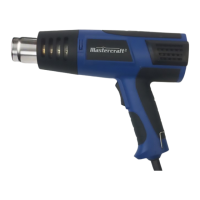
